Queer as folklore: A year of English customs
- Published
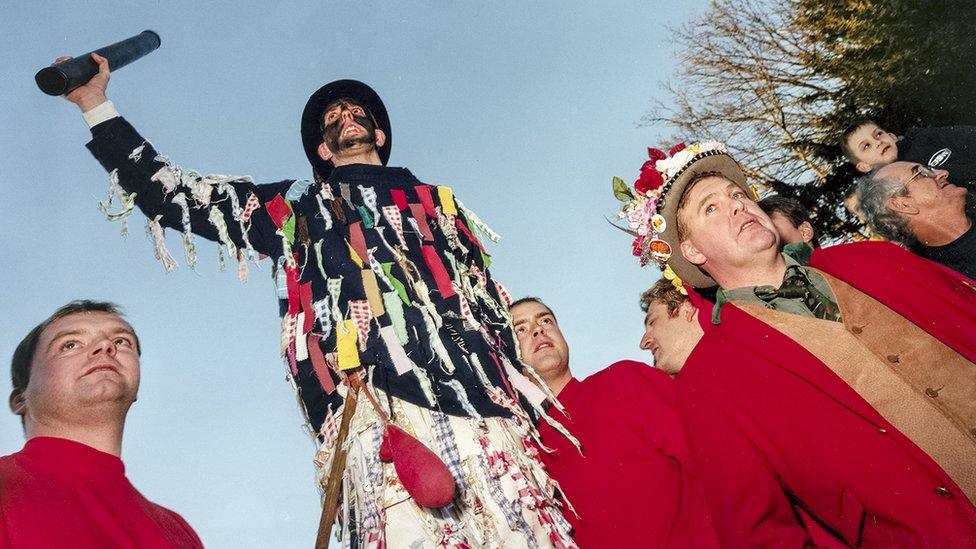
A speech is made before the Haxey Hood game begins
England is awash with curious customs dating back hundreds of years. Photographer Andrew Robinson spent five years during the 1990s capturing these strange and colourful traditions, which are still on-going. Now they are being revealed publicly for the first time.
The photos from his Another England project are being exhibited to coincide with the launch of the Centre for Contemporary Legend, external at Sheffield Hallam University.
Haxey Hood, Haxey, Lincolnshire
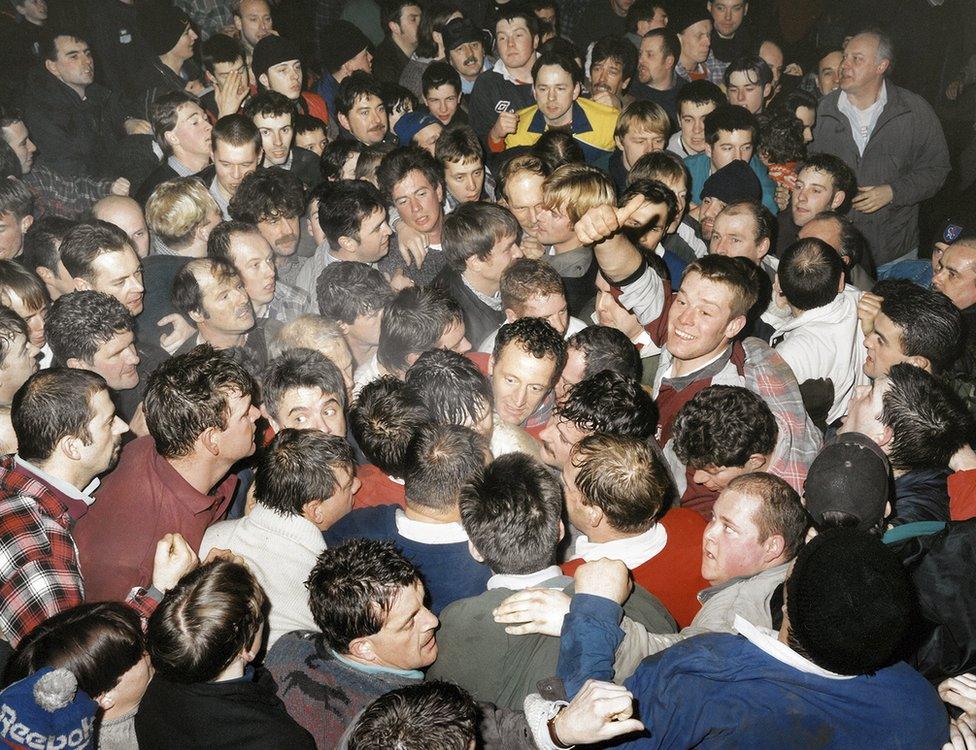
The Sway can involve up to 300 people, all battling to move the hood to their pub of choice

On 6 January a cry rings out across the Lincolnshire countryside.
"Hoose agen hoose, toon agen toon, if a man meets a man, knock 'im doon, but doan't 'ot 'im."
These words signal the start of the Haxey Hood, a mass rugby-style game dating back to the 14th Century.
A leather tube about a metre long - the hood - is thrown into the air and participants attempt to move it in a scrum, known as the sway, to one of a number of pubs in Haxey and the neighbouring village Westwoodside.
The hood cannot be thrown and no one is allowed to run with it. At any one time the sway can vary in size between 150 to 300 people, all pushing and pulling in a bid to get the hood to one of the pubs.
The event does not start until mid-afternoon and can go on well into the evening.
"To people who live here it's more important than Christmas I dare say," says Luke Coggon, who lives in Haxey.

The Haxey Hood is said to date back to the 14th Century
"People are very passionate and take it very seriously. For me, there's nothing else like it.
"There have been injuries in the past, but everybody tries to look after each other."
The tradition is said to have started when Lady de Mowbray, the wife of a local landowner, was out riding when her riding hood was blown off.
She was so amused to see local farm workers chasing it she rewarded them with land - on condition the chase be re-enacted every year.
Cradle Rocking, Blidworth, Nottinghamshire

The rocking ceremony has its roots in the Bible
Rumoured to be the resting place of Robin Hood's merry man Will Scarlett, the village of Blidworth is also known for its rocking ceremony.
Thought to be at least 400 years old, the ceremony takes place at the church of St Mary of the Purification in February.
According to tradition the baby boy born closest to Christmas Day is rocked in a cradle adorned with white and gold flowers while a passage from the Bible is read.
The ceremony derives from the story of the baby Jesus being presented at the Temple in Jerusalem 40 days after his birth.
Despite falling out of practice twice and being banned during the Reformation, it has been held annually since 1922, when it was last revived.
Hazel Robinson, the Vicar of Blidworth and Rainworth, said: "It's rather beautiful. About 100 people attend and we have large oak boards with the name of every child that has been rocked since 1922.
"Last year the family who had the "rockings baby" knew about the ceremony and were eagerly anticipating the birth of their child and hoping it would be a boy."
Britannia Coconut Dancers, Bacup, Lancashire
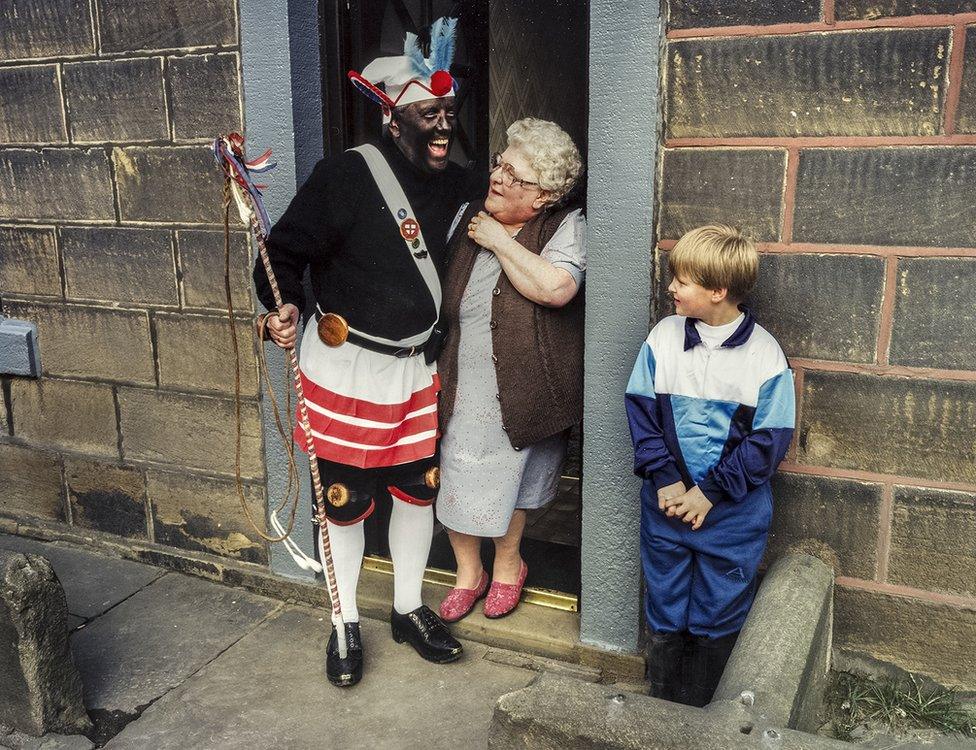
The Britannia Coconut Dancers' colourful costume is said to be derived from outfits worn by Moorish Pirates
Dressed in their red and white skirts, The Britannia Coconut Dancers of Bacup have been performing the same seven dances every Easter Saturday since at least the 18th Century.
Their costume is said to have been inspired by Moorish Pirates, who, according to dancer and group secretary Gavin McNulty, found their way to Bacup via the tin mines of Cornwall, bringing their deep mining skills to north-west England when work dried up in the south.
The dancers blacken their faces - a practice which has drawn some controversy - but Mr McNulty said this referenced the Moors' mining heritage and the pagan belief it would ward off evil spirits.
From dawn till dusk they dance between the towns of Whitworth and Stacksteads, stopping at each pub to perform and earn themselves a free drink.
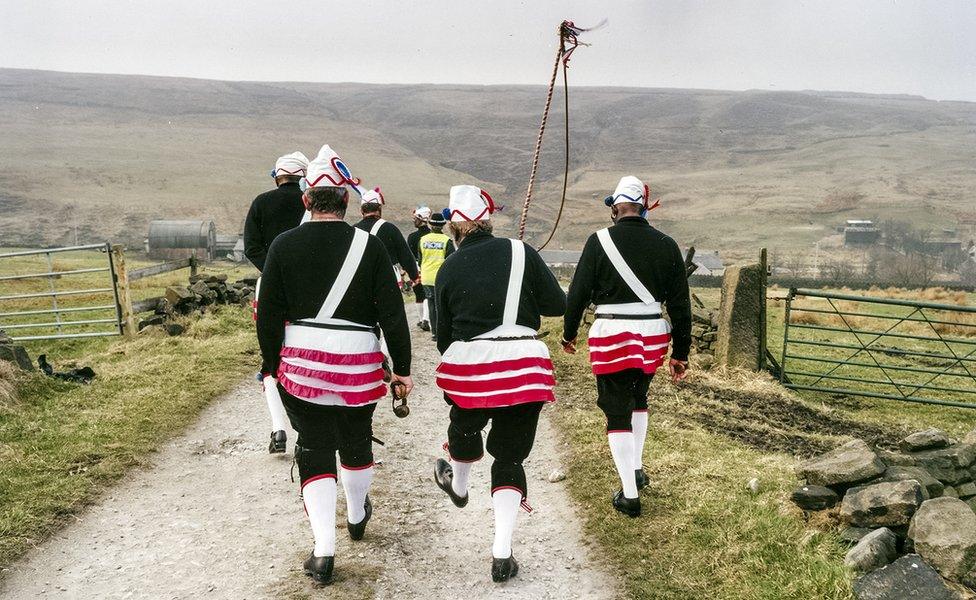
The dancers have been strutting their stuff since at least the 18th Century
The dances, many of which represent the changing seasons, are performed with wooden discs - or "coconuts" - strapped to the dancers' hands, knees and midriff.
"It's probably one of the main days of the year in the town," said Mr McNulty, who together with his father is one of about 20 members aged between 21 and 80.
"I didn't quite understand it before I started and what was involved but now I'm part of it I will do everything I can to keep the tradition going."
Maypole Raising, Barwick in Elmet, Yorkshire
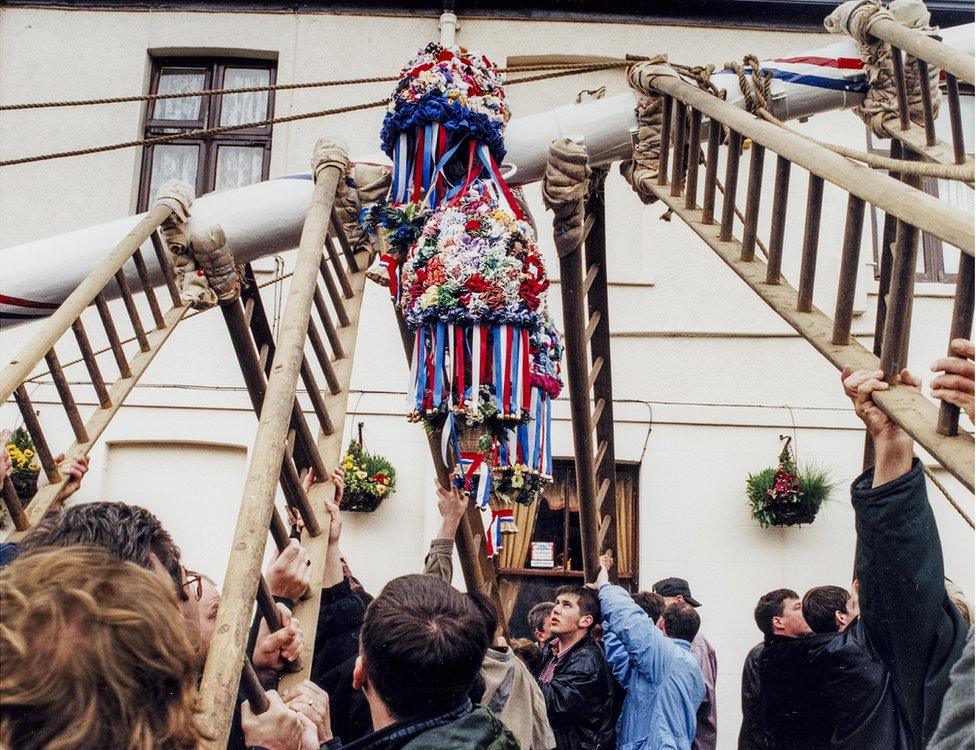
More than 100 people used to be needed to raise and lower the maypole in Barwick-in-Elmet
Once every three years in Barwick-in-Elmet, a small village to the east of Leeds, one of England's tallest maypoles is taken down to be repaired and repainted.
The 90ft (27m) pole is lowered on Easter Monday and raised again on Spring Bank Holiday Monday.
The feat requires more than 100 people and until 1999 was done entirely by hand, using ropes and ladders to push, pull and lever it back in to place.
However, Mark Vipond, chair of the Maypole Trust, said the centuries-old method had since been scrapped in favour of a crane after insurers caught wind.
"It was a certain loss of tradition and the village was not happy about it but we either had to find a new way or we would lose it completely," he said.
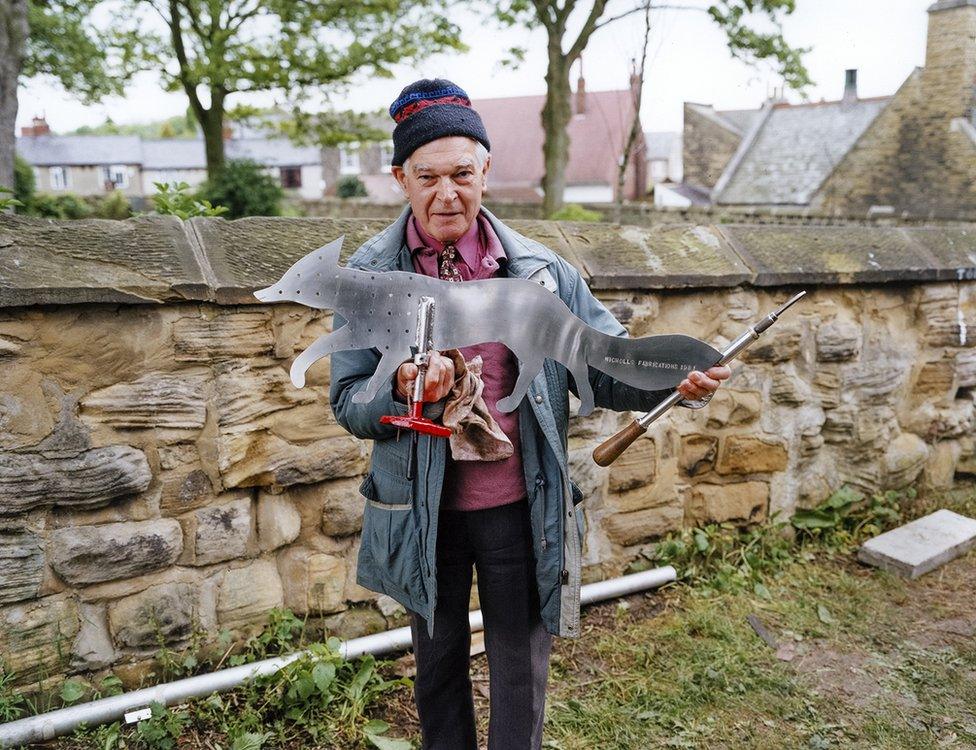
A silver fox weather vane sits at the top the maypole
The festivities are rounded off with a climber scaling the pole to spin the weather vane at the top.
The cost of repairing the maypole is about £14,000 and while fundraising can be tight it is a "labour of love" for the village.
"The ceremony is unique to us and that's one of the reasons we work so hard to keep it going," says Mr Vipond.
"[If we stopped] it wouldn't be Barwick in Elmet that didn't have a maypole ceremony any more, it'd be England."
Padstow Obby Oss, Cornwall
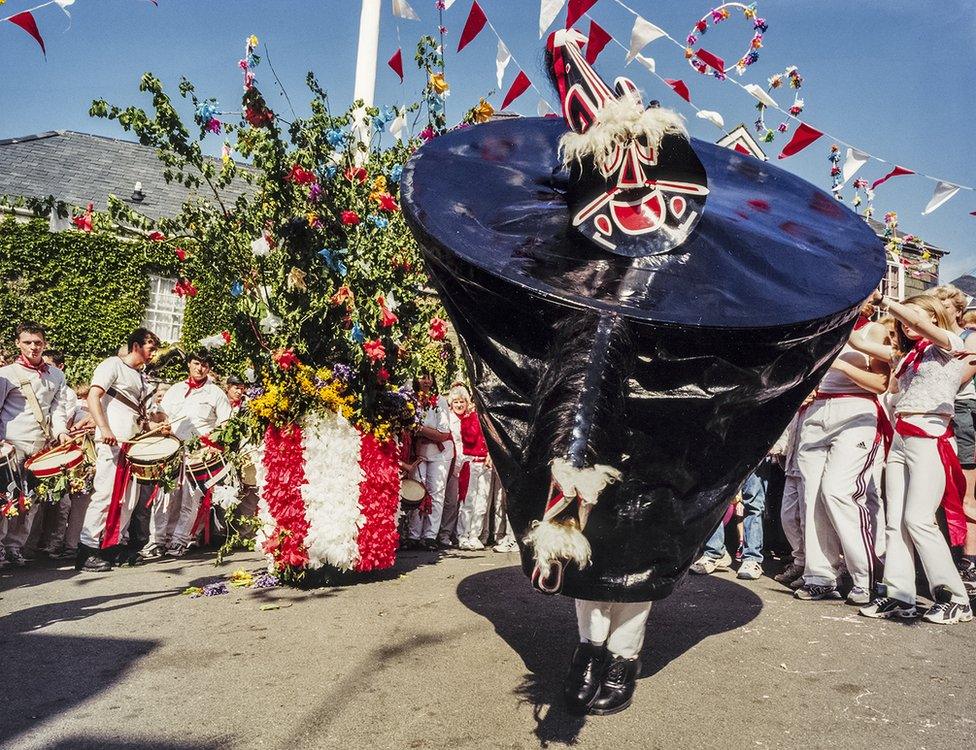
Padstow's May Day celebrations attract thousands to the seaside town
The Padstow Obby Oss, or Hobby Horse (though don't say that to a local), is "Christmas and birthdays and everything rolled into one for most people", according to local historian, 83-year-old John Buckingham.
Celebrations begin as the bells of St Petroc's strike midnight on 1 May and do not stop until late in the day.
The town is awash with singing and dancing centred around two Obby Osses - the Old Oss and the Blue Ribbon or Peace Oss.
Led by "teasers", the osses are paraded through the streets accompanied by dancers, drums and accordions, drawing crowds of up to 40,000 to the Cornish fishing port.
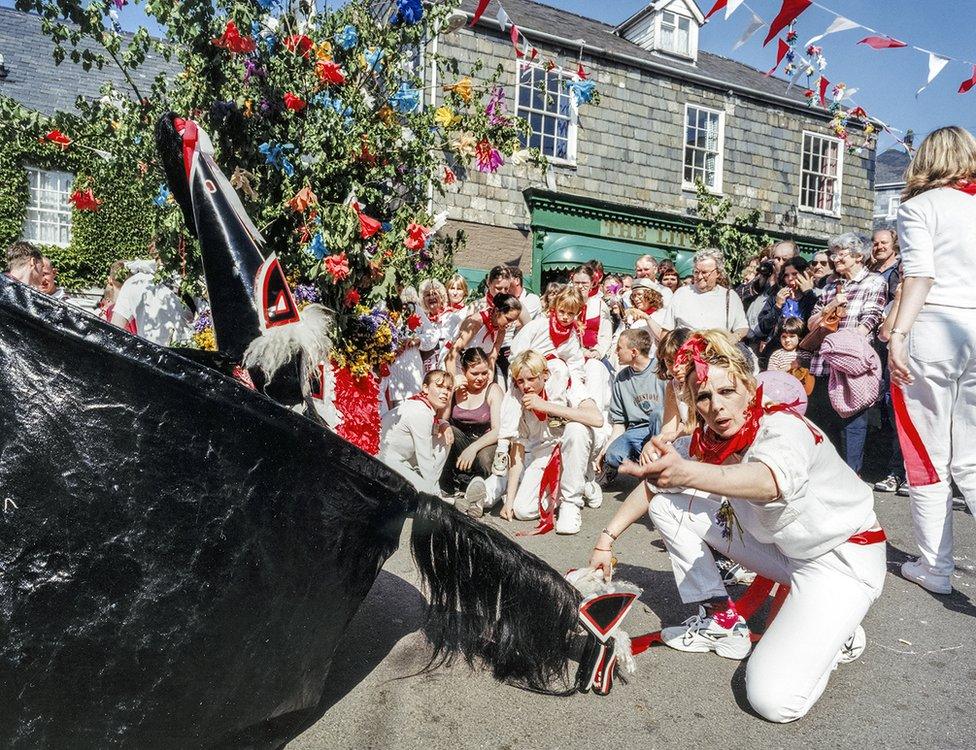
Two Obby Osses are led through the streets, the Old Oss and the Blue Ribbon or Peace Oss
Mr Buckingham said the tradition was hugely popular among locals.
"There are young people in the town who can't wait to carry the Oss, it's a rite of passage," he said.
"Cool or not, I do not know, but it's cool if you're a young Padstownian."
Bawming the Thorn, Appleton, Cheshire
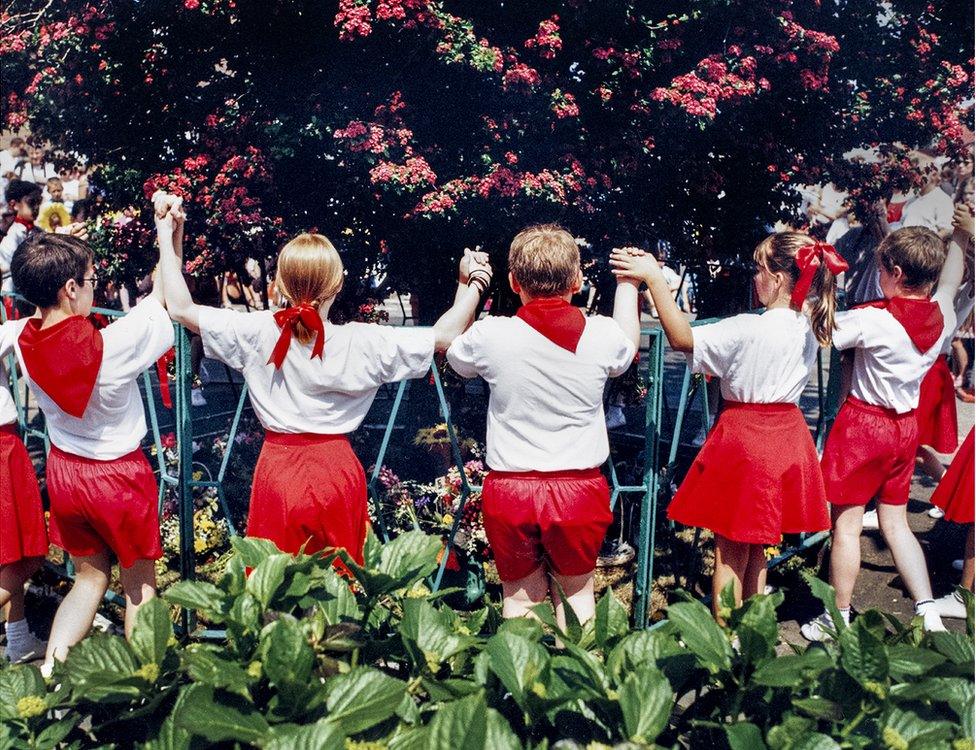
During the Bawming ceremony children dance and sing around the thorn tree
Opposite St Cross Church, in Appleton, Cheshire, there once stood a thorn which was thought to be an offshoot of the Glastonbury Thorn.
It was said to have been planted in the village, just south of Warrington, Cheshire, in the 12th Century by the knight Adam de Dutton.
While the original tree has been replaced, on the third Saturday of June the ceremony known as Bawming the Thorn still takes place.
The thorn is decorated with flowers and ribbons by children from the nearby school as they dance and sing round it.
Like many other customs it slipped out of existence in the early 20th Century but was revived in the 1970s.
Septennial Boundary Riding, Richmond, Yorkshire

Boundary Riding has been taking place in Richmond, Yorkshire, since 1575
Every seven years the people of Richmond, North Yorkshire, walk a 14-mile path around the town's boundary.
"We think 2018 was the 63rd time it's been done since it began in 1575, dating back to the charter of Queen Elizabeth I," says Heather Lawler, the town clerk.
"The original intention was to identify and proclaim the boundary of the town, and to check that nobody has violated the charter or taken any land."
At the head of the procession is the Pinder, who is armed with an axe to remove anything in his path.
He leads the mayor around the boundary, including through the middle of the River Swale, and at 18 locations the town crier declares the "ancient and undoubted boundary" of Richmond.
Mrs Lawler said: "We have a lot of history here, the cobbled market place, the castle, the abbey and to maintain that history is all part of living in Richmond."
Horn Dance, Abbots Bromley, Staffordshire
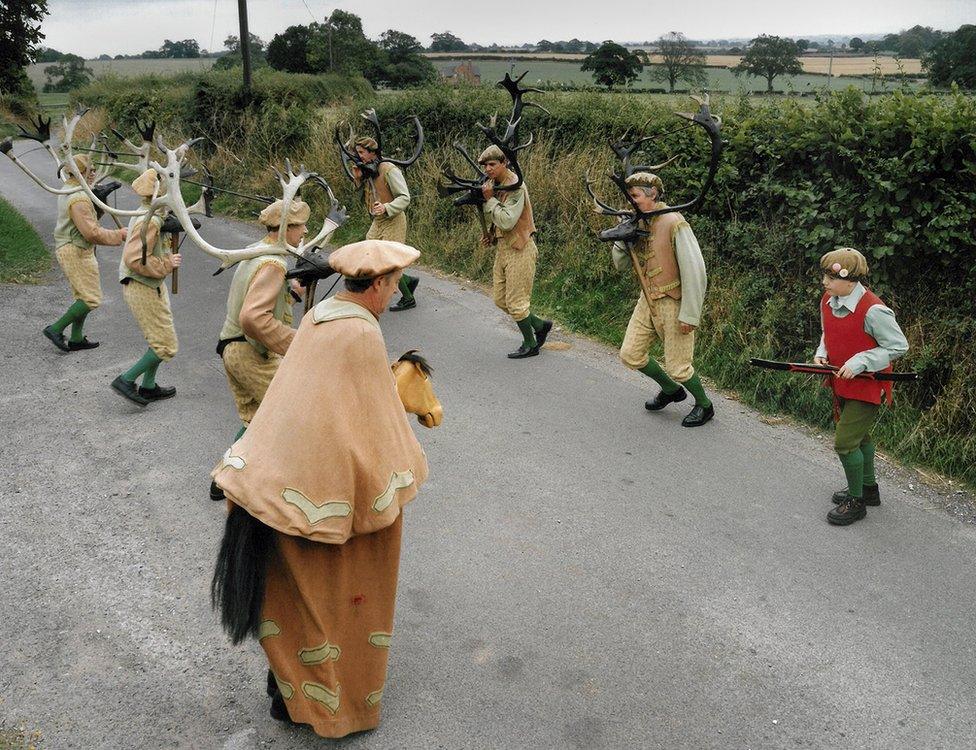
The horns used in the performance are thought to be the same used in the first performance in 1226
Records show the Horn Dance was first performed at the Barthelmy fair in the Staffordshire village of Abbots Bromley in 1226.
It is held on the first Monday after the first Sunday after 4 September, known as Wakes Day.
It has only been cancelled once - in the 1920s - and only then because one of the dancers had died.
The Horn Dance is performed by a troupe of six Deer Men - who each carry antlers weighing between 16lb (7kg) and 26lb (11kg) - a Fool, Hobby Horse, Bowman, and Maid Marion.
It is said the horns they carry are the same as those used at the first performance more than 790 years ago.
Ken Walkeden, 54, who has played the role of Hobby Horse for the past six years, said the horns had been carbon dated in the 1970s and shown to be more than 1,000 years old.
He said: "There's a belief the Vikings may have brought the reindeer horns over, but how they became a part of a dance in Abbots Bromley is a mystery."
He said the dance was believed to be associated with fertility and crops but its exact origins are shrouded in time.
"It is what it is," he added.
"We may look like a bunch of blokes having a drink and having a laugh but we're deadly serious. If you break us open it's in there."
Wroth Silver, Knightlow Hill, Warwickshire
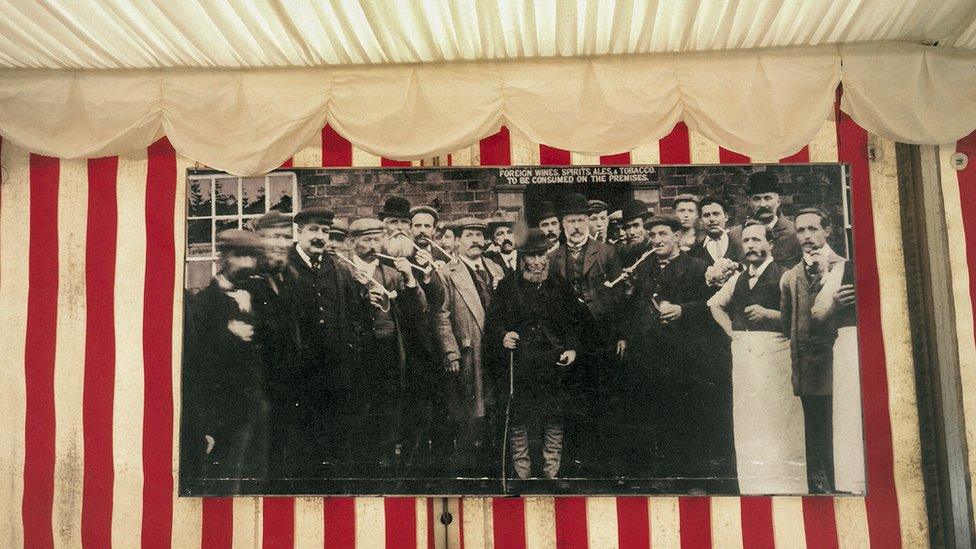
Tradition dictates that after the ceremony participants enjoy a drink of hot milk and rum and a smoke on a pipe
The ancient Wroth Silver ceremony is derived from the annual tax paid to the local landowner, records of which can be found in the Domesday Book of 1086.
At about 06:45 GMT on 11 November the princely sum of 46p - originally nine shillings and four pence - is deposited in the hollowed out base of an old Anglo-Saxon cross.
The group then toast the landowner - the Duke of Buccleuch - with hot milk and rum and, in days gone by, a smoke of a long-stemmed pipe, known as a Churchwarden.
Honorary organiser David Eadon, 84, who has attended 81 consecutive ceremonies, said: "It seems such a small amount of money today, but obviously once upon a time it was quite a sum, especially when you consider in the 14th Century a cottage cost about 10 shillings.
"We believe, originally, the money went towards paying officers paid for by the crown to protect the people in the parishes that made up the Hundred of Knightlow."
The payment was compulsory until about 1800 and the fine for non-payment was one pound for every penny not forthcoming, or to provide a white bull with a red nose and ears.
- Published29 December 2018

- Published30 November 2018
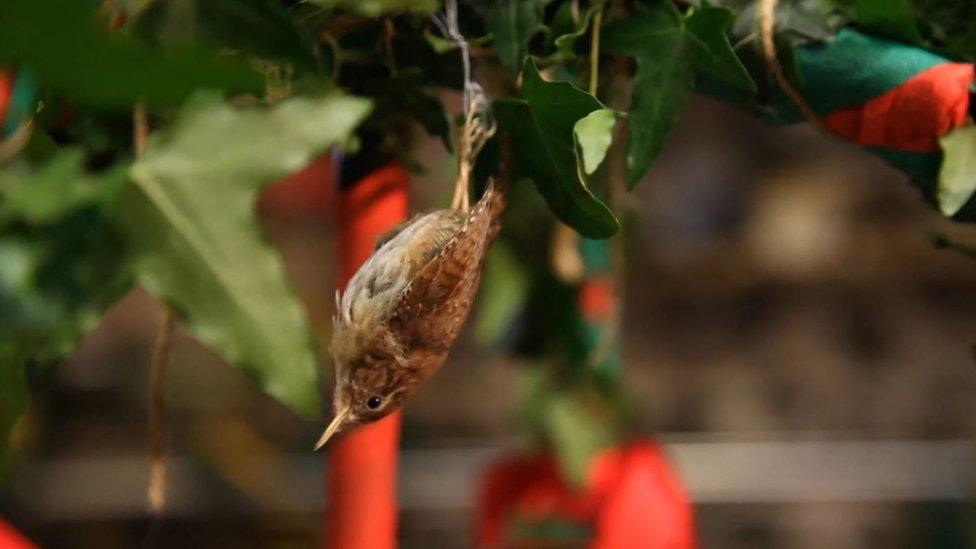
- Published30 October 2014
